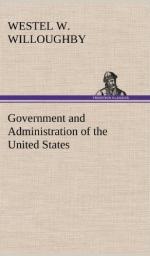Until 1866 this matter was left entirely to the States, as permitted by the section of the Constitution just given. In that year an act was passed by the Federal Congress regulating the election of senators by the State Legislatures. By it was provided that the Legislature of each State, which is chosen next preceding the expiration of the term of either of their senators, shall on the second Tuesday after assembling elect a senator in the following manner: Each House shall by open ballot (viva voce) choose some man for senator, and he who receives a majority of the total number of votes cast in such House is entered on the journal of that House. At noon on the following day the members of the two Houses convene in joint assembly, and the journal of each House is then read, and if the same person has received a majority of the votes of each House he is declared duly elected senator. But if not, the joint assembly then proceeds to choose by a viva voce vote of each member present, a person for senator, and the person who receives a majority of all the votes of the joint assembly—a majority of all the members elected to both Houses being present and voting—is declared duly elected. If no person receives such a majority on the first day, the joint assembly meets at noon on each succeeding day during the session of the Legislature, and takes at least one vote until a senator is elected. In case of a vacancy occurring in the Senate during the recess of the State Legislature, the governor appoints a man to fill the place, his appointee holding until a successor shall be chosen in the above method by the State Legislature.
In the House, when vacancies happen in the representation from any State, the Governor issues an order for a new election in the congressional districts in which such vacancies occur. The representatives thus elected hold office for the unexpired terms of their predecessors.
CHAPTER IX.
Congressional Government.
The Constitution created Congress and conferred upon it powers of legislation for national purposes, but made no provision as to the method by which these powers should be exercised. In consequence Congress has itself developed a method of transacting its business by means of committees.
The Federal Legislature consists of two Houses—the Senate, or Upper and less numerous branch, and the House of Representatives, or the Lower and more numerous popular branch.
The Senate is composed of two members from each State elected by the state legislatures for a term of six years, one-third of whom retire every two years. The presiding officer is the Vice-President. Early in each session, the Senate chooses a President pro tempore, so as to provide for any absence of the Vice-President, whether caused by death, sickness, or for other reasons.
The House of Representatives is at present composed of 332 members and four delegates from the Territories. These delegates, however, have no vote, though they may speak. The House is presided over by a speaker, elected at the beginning of each session. A quorum for business is, in either House, a majority.




